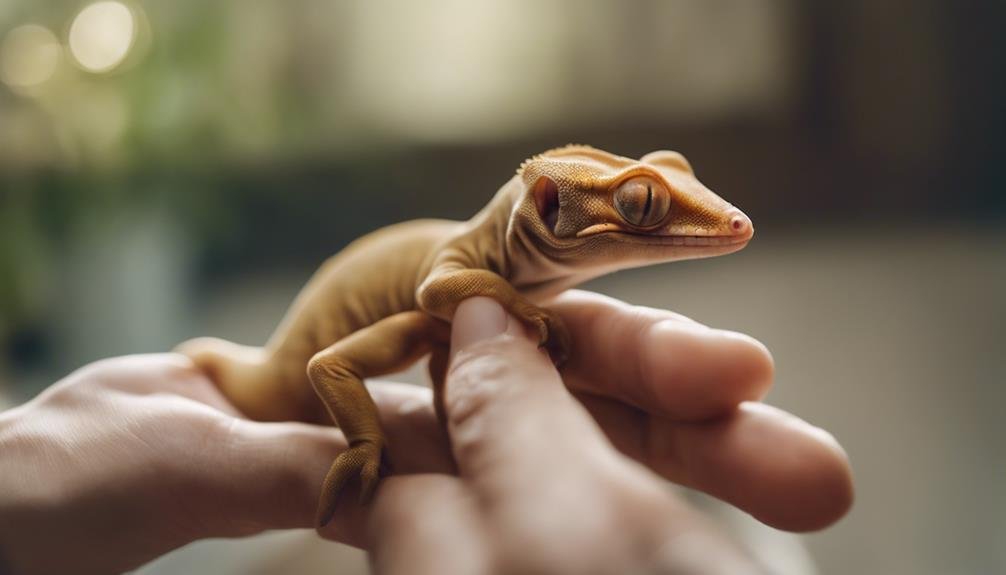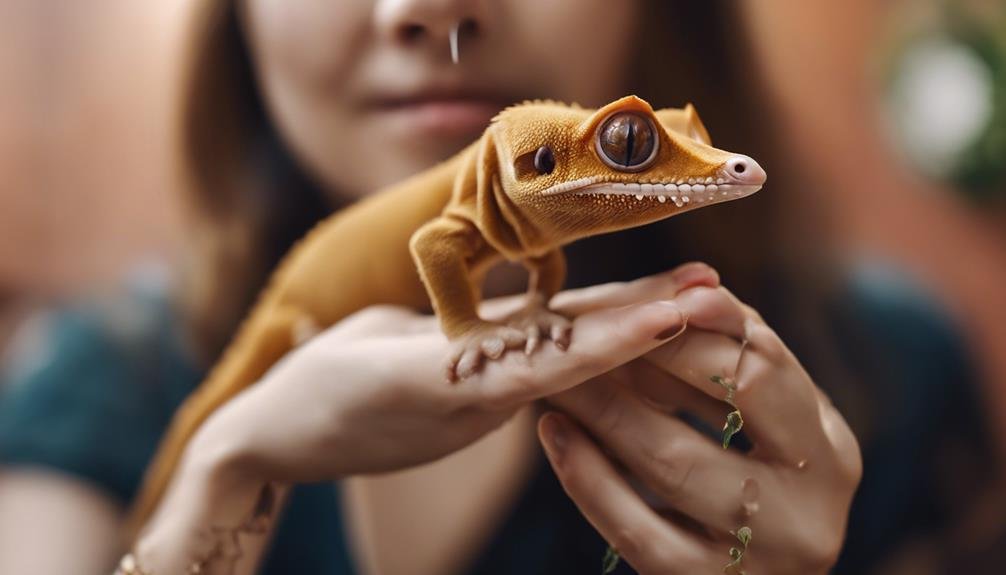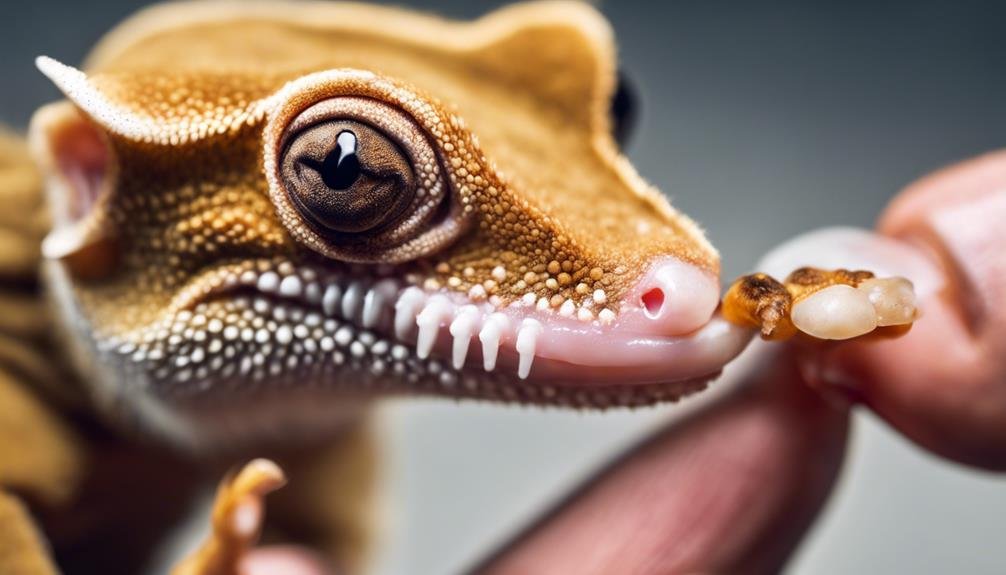You might wonder if your crested gecko's smile hides any teeth and, if so, how you can prevent an unexpected nip. Yes, these fascinating reptiles do have small teeth, designed more for gripping than causing harm. However, understanding their behavior and stress signals is key to avoiding bites. It's not just about avoiding those tiny teeth; it's about fostering a relationship where bites are off the table. But how do you achieve that? The journey to a bite-free interaction with your crested gecko involves more than just careful handling; it requires a deeper insight into their world. Let's explore how you can create a stress-free environment for your gecko, ensuring both of you enjoy a harmonious relationship.
Key Takeaways
- Crested geckos have tiny teeth primarily used for gripping their prey, not for chewing.
- Biting in crested geckos is rare and usually happens during handling, mating, or territorial disputes.
- To prevent bites, avoid over-handling and monitor the size of the food offered to reduce stress.
- Recognize signs of agitation, such as gaping mouth and tail flicking, to avoid provoking a bite.
- Gentle and consistent handling, along with creating a stress-free habitat, can minimize biting incidents.
Crested Gecko Teeth Explained
Crested geckos have tiny teeth that are primarily used for gripping their prey rather than chewing. These small, yet effective teeth play a vital role in their survival, especially when it comes to feeding. As a crested gecko owner, you'll find their teeth aren't designed for heavy-duty chewing. Instead, these reptiles are adapted to a diet that doesn't require much breaking down. They prefer to swallow insects whole and enjoy soft, over-ripe fruits or pureed foods that are easy to consume without the need for significant chewing.
Because their teeth can't chew in the way mammals do, it's important to monitor the size of the insects you're feeding your crested gecko. To prevent choking, never feed them insects larger than the space between their eyes and mouth. This simple rule ensures that the prey is small enough for them to safely manage. Understanding the limitations and purpose of your crested gecko's teeth is key to providing them with a safe and appropriate diet, minimizing the risk of any feeding-related issues.
Understanding Biting Behavior
After exploring the structure of crested gecko's teeth, let's now focus on their biting behavior and how you can prevent it. Crested geckos have small teeth that aren't meant for chewing but are perfect for catching and swallowing their prey whole. When it comes to human interaction, it's important to understand that biting isn't common in these creatures. However, it can occur mainly during their initial handling phase, mating periods, or territorial disputes among them.
Most biting incidents happen due to over-handling, especially when they're not yet accustomed to it. It's vital to give your crested gecko time to get used to being handled to prevent any accidental bites. Males might also grip females with their teeth during mating, which can leave bite marks, but these generally heal well without intervention.
To further minimize the risk of biting, pay attention to the size of the food you're offering. Oversized food can cause stress, leading to biting out of frustration. Remember, aggressive behavior in crested geckos is rare. Still, signs of agitation, such as a gaping mouth or tail flicking, are clear indicators of stress or anger. Recognizing these signs early can help you avoid situations where biting could occur.
Signs of Impending Bites


Understanding a crested gecko's warning signs can save you from an unexpected nip. These small creatures, although not naturally aggressive, do have tiny teeth designed to grip their prey rather than chew it. When they're about to bite, they don't just lunge without warning. Instead, they show clear signs of agitation.
If you notice your crested gecko gaping its mouth, flicking its tail, or making unusual clicking and squeaking noises, it's signaling discomfort or fear. These aren't mere quirks or playful gestures but indicators of a stressed gecko that feels threatened. Agitated behavior, such as wide-eyed staring or puffing up its body, further underscores its distress. This is the gecko's way of saying it needs space.
It's important to heed these warnings. When you see these signs, the best course of action is to back off. Avoid the temptation to handle or soothe your gecko when it's clearly showing it wants to be left alone. Recognizing and respecting these boundaries not only prevents bites but also helps in building a trusting relationship between you and your crested gecko.
Biting: Myths Vs. Reality
You might've heard some tall tales about crested geckos and their bites, but let's separate fact from fiction.
While it's true they've teeth, their bites are hardly a cause for alarm due to their nature and feeding habits.
We'll explore the myths surrounding their biting behavior and reveal what's actually true, ensuring you're well-informed.
Myths About Biting
Dispelling myths about crested geckos biting reveals that these incidents are usually minor, more akin to a nip than a harmful bite. You might've heard tales of crested geckos intentionally inflicting harm or causing severe injuries. However, the reality is far from these misconceptions.
Crested geckos have small teeth designed not for chewing but for gripping onto their prey. This means their bite is more of a pinch or nip, lacking the power to cause serious harm. Bites occurring during natural behaviors like mating or establishing territory typically don't lead to significant injury. Understanding this can ease your fears, encouraging safer handling practices and a better relationship with your crested gecko.
Biting: What's True
Let's separate fact from fiction: crested geckos' bites are more gentle nips than harmful chomps, despite common myths. You've likely heard tales of these little creatures delivering painful bites, but here's the reality: their small teeth and limited biting power mean you'll hardly feel a thing if they do attempt a nibble. Most biting occurs due to stress, over-handling, or during mating rituals—a natural behavior, not aggression.
| Aspect | Myth | Reality |
|---|---|---|
| Teeth | Sharp and dangerous | Small, for gripping prey |
| Bite Feeling | Painful | Barely noticeable |
| Reason for Bite | Aggression | Stress, handling, mating |
| Prevention | Avoid at all costs | Monitor insect size, handling |
Understanding your crested gecko's behavior and needs can prevent most biting situations.
Preventative Handling Techniques


To prevent bites, always handle your crested gecko gently and with care. Crested Geckos are sensitive creatures, and rough handling can lead to stress, which may cause them to bite in defense. It's important to move slowly and avoid sudden movements that could startle your gecko. Quick, unpredictable motions can provoke fear, leading to a defensive bite.
When feeding your crested gecko, consider using tongs to offer food. This method not only keeps your fingers away from their mouth but also helps in maintaining a safe distance, reducing the chances of an accidental bite. Creating a comfortable and stress-free habitat is equally vital. A well-set environment keeps your gecko calm, minimizing aggression and the likelihood of biting.
Regular interaction with your crested gecko builds trust and familiarity. Start with short sessions and gradually increase the time as your gecko becomes more accustomed to your presence. This consistent, gentle handling teaches your gecko that you're not a threat, greatly decreasing the likelihood of bites. Remember, patience and consistent gentle handling are key in preventing bites and establishing a positive relationship with your crested gecko.
Response to Gecko Bites
If you're ever on the receiving end of a crested gecko bite, it's important to know how to respond. Treating the wound promptly and understanding the low risk of infection are your first steps towards recovery.
You'll also learn how to soothe the bitten area properly, ensuring both you and your gecko can move past the incident with minimal stress.
Treating Gecko Bite Wounds
Upon experiencing a gecko bite, it's important to first wash the affected area with soap and water to prevent infection. Treating gecko bite wounds promptly helps guarantee they heal without complications, especially since most bites are superficial.
If the bite manages to break the skin, applying an antiseptic ointment is a vital next step to ward off any potential infections. It's rare for these bites to cause serious harm, but monitoring the bite site for any unusual changes is wise.
Should the area become red, swollen, or increasingly painful, it's time to seek veterinary advice. Remember, reacting calmly to the bite not only aids in your treatment process but also minimizes stress for your gecko, teaching it that biting isn't an effective means of communication.
Understanding Bite Infections Risk
After addressing the immediate care for a gecko bite, it's important to understand the risk of infections these injuries might pose. Crested geckos have small teeth that rarely break the skin, which greatly reduces the risk of infection from their bites.
Usually, a crested gecko bite feels more like a nip or punch and is generally painless, minimizing the likelihood of serious infections. The risk of infection from gecko bites is low due to their limited biting power and the small size of their teeth.
However, it's essential to wash the bite area with soap and water promptly to help prevent any infections. You should also monitor the bite for signs of infection and seek medical attention if necessary to prevent complications.
Calming Bitten Areas Properly
Immediately wash the bitten area with soap and water to clean and disinfect the wound, reducing the risk of infection. When a crested gecko bite happens, it's vital to act swiftly to minimize complications.
After cleaning, the next steps will further aid in the healing process and comfort.
- Apply an antiseptic ointment gently over the bite, creating a barrier against bacteria.
- Monitor the bitten area closely for any signs of redness, swelling, or unusual discharge.
- If symptoms of infection appear, don't hesitate to seek medical attention promptly.
- Remember, it's important to convey to your gecko that biting isn't acceptable, using calm and patient training methods.
Taking these steps will help ensure a quick recovery from a crested gecko bite and prevent future incidents.
Health Risks and Care
Understanding the health risks and proper care of crested geckos is crucial to prevent injuries and guarantee their well-being. Crested geckos possess small teeth designed primarily for grasping, not chewing. This means you've got to keep an eye on the size of the food you're offering. They can't handle large insects or hard fruits well, as they tend to swallow their prey whole or munch on soft, over-ripe fruits. To avoid any risk of choking, always make sure their meals are appropriately sized.
Bites from these creatures are a rarity, often only occurring when they feel over-handled or during mating season. It's not unusual for male geckos to leave bite marks on females as part of their natural mating ritual. However, you can largely prevent these incidents. Start by keeping handling to a minimum initially, gradually letting your gecko get accustomed to your presence. Over time, as they become more comfortable with you, the chances of nipping or aggressive behavior can decrease significantly. Remember, patience is key when building a relationship with your crested gecko, ensuring a safe and happy environment for both of you.
Enhancing Gecko Interaction Skills


Building on the foundation of health and safety, let's now focus on how you can enhance your interaction skills with your crested gecko. These friendly and docile reptiles thrive on positive connections with their human companions. By fostering a bond through respectful and gentle engagement, you'll not only prevent bites but also enjoy a rewarding relationship with your gecko.
To create vivid imagery in your mind, imagine:
- Offering tiny pieces of fruit or special gecko treats from your hand, rewarding your gecko for calm behavior and slowly building trust.
- Holding your gecko gently for short periods, gradually increasing the time as they become more comfortable with you.
- Setting up a cozy and secure environment with hiding spots and climbing branches, making your gecko feel safe and at home.
- Being consistent and patient, understanding that trust takes time to develop, and every small step forward is a victory.
Can the Prevention of Mouth Rot in Leopard Geckos Help in Preventing Bites from Crested Geckos?
Mouth rot prevention and treatment for leopard geckos is crucial for their overall health. While it may not necessarily prevent bites from crested geckos, maintaining good oral hygiene in leopard geckos can contribute to their general well-being and reduce the risk of health issues, including mouth rot.
Frequently Asked Questions
How Bad Is a Crested Gecko Bite?
You're likely wondering about the pain level of a crested gecko bite. Well, it's pretty mild. These little creatures have small teeth that can't really break the skin, so if they do nip you, it feels more like a gentle pinch than anything serious.
The bite won't make you bleed or leave a mark. Their bites are more about defense or showing who's boss rather than causing harm. So, there's no need to worry much about pain assessment with these guys.
How Do You Treat a Gecko Bite?
If you've been bitten by a gecko, start by cleaning the area with soap and water for proper bite care. Then, apply an antiseptic ointment to help it heal.
Keep an eye on the bite for signs of infection like redness or swelling. If it looks infected or you're worried about the gecko's health, don't hesitate to seek medical advice.
Also, work on training your gecko to understand that biting isn't okay to avoid future bites.
Why Did My Gecko Bite Me?
Your gecko probably bit you due to stress, fear, or confusion, thinking your fingers were food. Improving your handling techniques can make a big difference.
Be gentle and avoid sudden movements that might scare them. Using tongs to feed them can also help, preventing them from associating your hands with food.
Watch for signs like tail flicking or mouth gaping, as these indicate they're getting agitated and might bite.
Why Is My Crested Gecko Attacking Me?
If your crested gecko is attacking you, it's likely due to handling mistakes or feeling threatened. They might mistake your fingers for food, feel stressed or scared, or react to improper handling.
To avoid bites, handle them gently, don't make sudden movements, and watch for signs of aggression like tail wagging or hissing. Understanding their behavior and respecting their space can greatly reduce the chances of an attack.
Conclusion
To sum up, yes, crested geckos do have teeth, but their bites are rare and usually not serious. Understanding their biting behavior and recognizing signs of stress can help you avoid getting bitten. By using gentle handling techniques and creating a comfortable habitat, you'll minimize the risk.
If a bite happens, it's typically minor. Prioritize building a trusting relationship with your gecko to enhance your interactions, ensuring both you and your pet enjoy a harmonious life together.



[…] Crested gecko teeth and bites are crucial to their behavior and well-being. Natural light helps regulate their circadian rhythm and supports their overall health. Without proper lighting, they may become stressed or irritable, leading to biting tendencies. Providing adequate natural light can positively impact a crested gecko’s behavior and reduce the likelihood of biting. […]